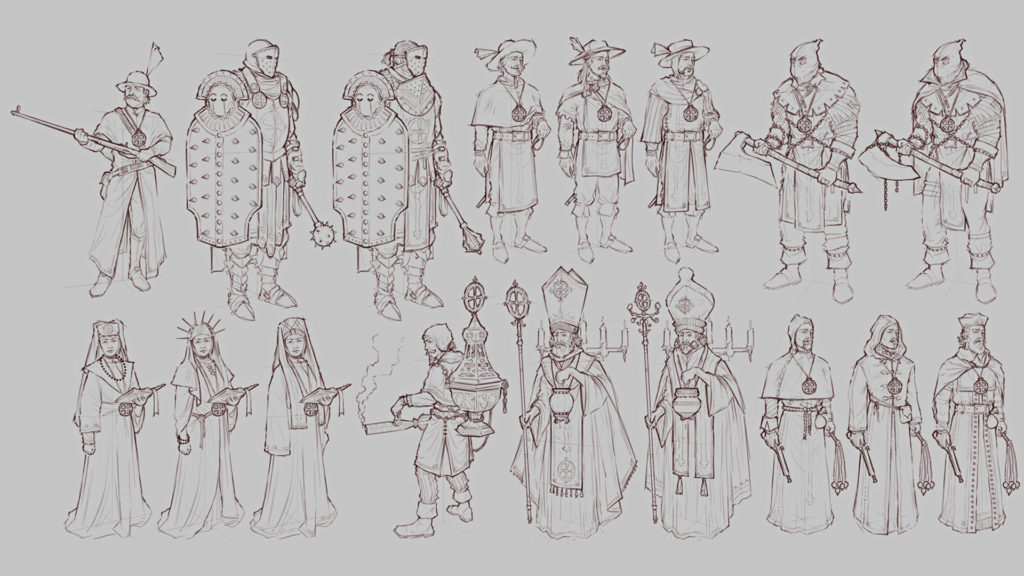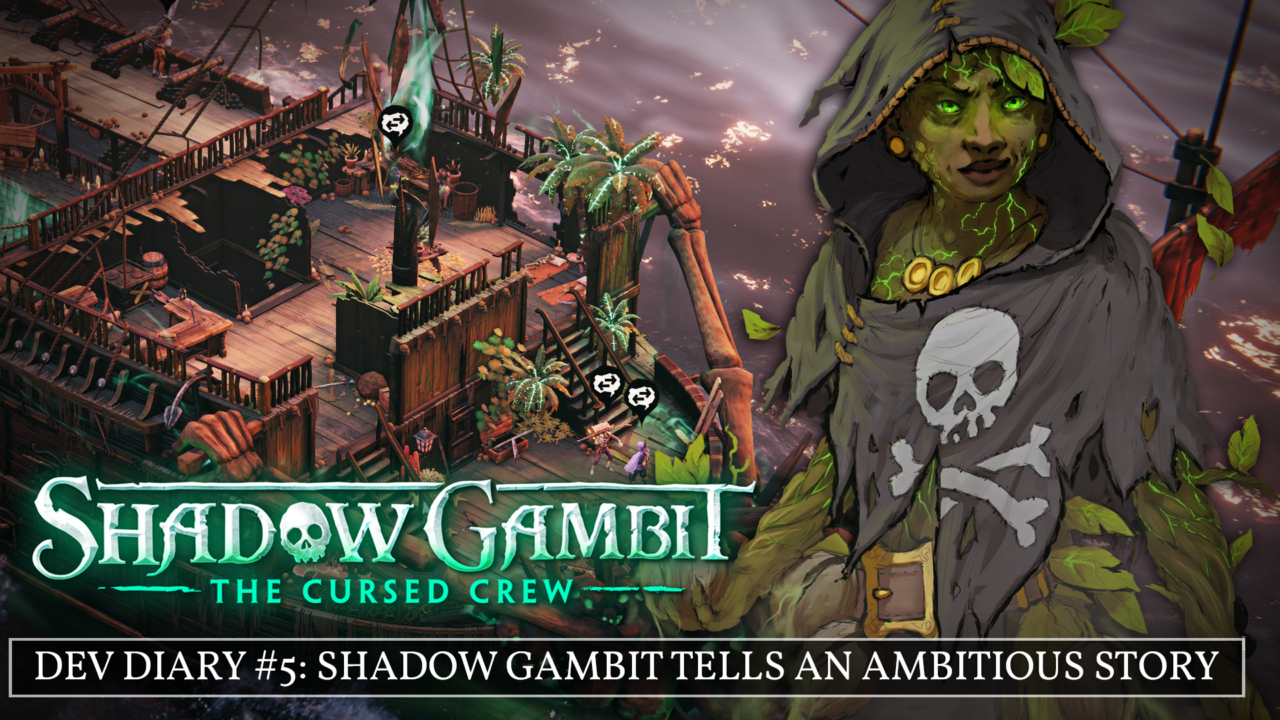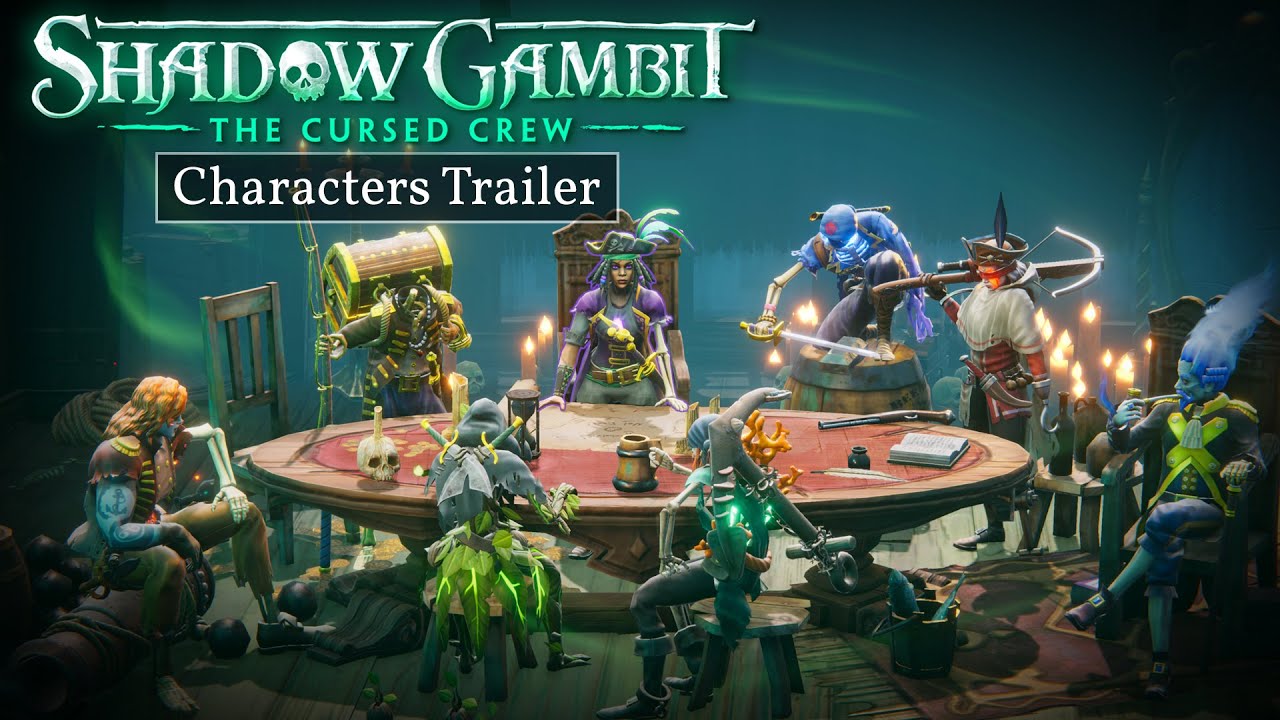Shadow Gambit: The Cursed Crew introduces a wide variety of different characters as part of your cursed pirate crew – as well as an open game structure. Our writers explain how they still manage to tell a captivating story.
Hey, I am Elena, Communications Manager at Mimimi Games – you probably already read from me, if you visit this blog or our social media frequently. With this monthly dev diary blog, I want to give our developers a chance to tell you about what it’s like to work on Shadow Gambit: The Cursed Crew and how their ideas and efforts shape the game.
While you just sit back and relax, I ask them everything you could possibly want to know about the game – after learning more about how to create the perfect mastermind moment for the player in the last one, it’s now time to have a closer look at the story and how the writers made it work with different characters and an open game structure. The game is already out, but don’t worry – we still won’t spoil anything here.
The most outstanding new idea of Shadow Gambit: The Cursed Crew is of course the magical pirate world the game is set in. Our lead writer Martin “Hambo” Hamberger explains how the team developed a new world with a lot of deep lore and different stories from scratch.
How to create a magical pirate world
You have to get started somewhere and in our case it was with pirates, as Hambo tells me:
“We wanted to do undead pirates. That was the baseline. The Caribbean part came fairly naturally, once we settled on an alternate history setting. We wanted to have enough basis in reality to get you comfortable, then pull you into a world that has been infused with strange magic. As people who grew up with everything from Monkey Island to One Piece, we had lots of inspiration to draw from. At first, we were a bit shy with the fantastical elements.”
“The world was fairly grounded, with most people unaware that magic was real. I think that’s because we were so used to grounded realism from our more recent games. But then we pushed ourselves to go big with magic, lore and concepts, and not forget the fun along the way. We wanted the Lost Caribbean to be a place that excites us just as much as it does the players.”
World meets lore
Look at this island trailer for Calamity Reef to get an idea of the mood we are going for:
Creating the lore for the world was a big part of the process, as he continues to explain:
“Imagine the Caribbean during the Golden Age of Piracy, only stranger. Death doesn’t mean what it used to here thanks to a curse that’s been hanging over these parts for over a century.”
“People are accustomed to wandering souls, undead pirates and ghostly magic that has infused land and sea itself. It’s a wild place where every island has new surprises in store for you. In the game, we only see a small part of what is now called the Lost Caribbean. There’s things we can only hint at, conflicts and factions that have changed the course of history as we know it.”

From witch hunters to the Inquisition
Some things actually made it into the final game, while others got cut or changed along the way:
“We had lots of ideas for different enemy factions got cut very early. For example, there were the Witch Hunters, mercenary crews who hunted Cursed Pirates for coin and worked with all kinds of hunting tools and talismans. Some of the islands you visit in the game had vastly different backstories as well.”
“One of them, which is still called ‘Ritual Island’ in the game’s code, used to have huge significance to the lore of the Cursed Pirates. But we changed it to something that fit better with the story we wanted to tell. I’m still glad we narrowed things down so we could tell a complete and well contained story in a larger world. Maybe we’ll get to revisit these ideas and explore more of the Lost Caribbean in the future.”
Finding the perfect Stealth Strategy villain
Now the Inquisition are the main evil force in the game – a fanatic cult the player and their cursed pirate crew try to defy. Hambo tells me a bit more about this dangerous cult:
“They are the main enemy faction you encounter in Shadow Gambit: The Cursed Crew. Pirates are all about individualism and personal freedom, so we wanted the antagonists to represent the opposite. We also wanted a faction that could accurately represent the realities of our game mechanics. For example, guards that patrol the same routes over and over again, complicated procedures for alarm, exact times for how long someone investigates a disturbance and so on.”

“The Inquisition is all about rules. They believe that by changing the world through these rules, it will be saved from the chaos caused by magic. It’s what they call the ‘Grand Design’. I think it’s important to understand why someone would want to join the Inquisition, even if the realities of their actions are often monstrous.”
“Now, when it comes to the main villain, I’d had the desire for the longest time to have someone in our games that could actively antagonize you in missions. In previous games, our villain’s actions were mostly restricted to cutscenes. Inquisitor Ignacia, who is your arch nemesis in Shadow Gambit, takes a much more active role. She has a few surprises up her sleeve that I’m very excited for people to see.”

How to tell a great story with an open game structure
Deciding which overarching story the writers wanted to tell, was also a very important part of creating the world of Shadow Gambit, as Hambo points out:
“After gravitating to a more cinematic, classic style in Desperados III, I had the desire to tell a story that you could only tell in our game.”
“This kind of thinking has influenced many of the directions and themes of the story. It’s where ideas like making the saving mechanic part of the world came from. Of course, we also wanted to tell a good story with fun pirate adventures and loveable characters. Looking back a it all now that it’s finished, I think it’s the best thing we’ve ever made.”
it’s all about the characters
The most demanding part of creating a story for Shadow Gambit was of course the open game structure the writers faced:
“It is challenging. Early on, we decided to use a very simple framework for the story. You’re working towards a larger goal, which is finding Captain Mordechai’s treasure. But many stand-alone stories happen on the way. It’s kind of like an old school TV show, where you maybe have a mid season high point and an end of season finale to create an arc, while the episodes in between are self-contained and could happen in any order.”
“Even with that framework, we had to juggle many different things, particularly because we didn’t know for the majority of the cast if they would be present in any given scene. We decided to anchor the main plot around a couple key characters, then give the rest of the crew more spotlight as the story develops, with individual character missions and lots of optional content to explore.”
The characters of Shadow Gambit are all very different and unique – have a look at them in our characters trailer:
Why being flexible is important
Even after figuring this out, they were still confronted with some issues. But they kept an open mind and made sure to never lose focus on what kind of story they wanted to tell with Shadow Gambit:
“I think you have to stay flexible. Problems always come up, especially when things change or get added, and you want to be able to handle it without your story falling apart. I feel like we did a good job this time around. We kept things lose enough so we could introduce new stuff or switch things around, within reason of course. There were one or two problems that cropped up very late in development that could have thrown a wrench in the works.”
“For instance, we miscalculated the number of times you return to your ship, because at some point, the requirements for reaching the final mission had changed. That could have negatively impacted the pacing of our plot, since a lot of important scenes took place on the ship. It ended up working because we’d kept things flexible.”
The Marley serves as Hub and home to your crew, you return to her in between missions and are able to explore her deck while talking to your crew and helping them with little tasks:

Designing dialogues and missions for random characters
But let’s get a bit more into the details – how did our writers make the actual dialogues work while letting you choose freely which characters to take on missions? Hambo talks a bit more about how conversations between the heroes work in Shadow Gambit and what anchor points the team defined for them:
“You go with the characters. Each member of our pirate crew has ambitions, personal preferences, an important job the ship, and so on. Throwing them into different situations where they play off each other was very rewarding creatively. Shadow Gambit lets us have character dialogue outside of missions for the first time, when the crew is just going about their daily life on the Red Marley.”
“That greatly helped fleshing out each crew member, since we couldn’t rely too much on mission dialogue this time around. In terms of worldbuilding, we did give some characters deeper ties to the history of the Lost Caribbean so we could sneak bits of lore in there. Since they’re undead, they can give accounts on events that lie centuries in the past. That was also a first for us.”

Great characters need great missions
Of course, for the dialogue to be appealing they also had to make sure the missions were actually fun to play from a narrative standpoint as well:
“You need a fun premise that leads to interesting gameplay. Breaking a smuggler out of a tightly guarded garrison. Hunting for treasure on a haunted graveyard. You come up with multiple steps to your goal, ideally things that profit from your setting. Talk to a secret contact disguised as an Inquisition Acolyte. Gather ingredients for a magic stew that can raise the dead. We talk to our level designer a lot so we know how to adjust pacing and where the ideal spot for a mission objective should be. It’s always a collaborative process.”
Not only with the game design department, but also the artists as Hambo explains further:
“Everyone works on stuff simultaneously, so you have to communicate a lot and be able to adapt if necessary. There’s often an initial idea for a location or a mission that has very little to do with the plot you’re just figuring out yourself. Everyone wants to do cool things with the initial ideas. We laid a lot of groundwork so we wouldn’t run into problems in case a particular mission or location didn’t fit into the overall narrative, which has happened to us in previous projects.”

The biggest challenge had nothing to do with the story itself
But of course, to bring the characters fully to life we also needed external support for localization and voice acting. Hambo tells me what the collaboration was like:
“We’re incredibly fortunate to work with the talented people at OMUK, who have done voice work for all our games since Shadow Tactics. It’s always a thrill to discover a character together with the actors and director. Once recording starts, they have just as much input as you do, and sometimes they come up with things you didn’t even consider.”
“For instance, when we started on Toya with Mark Takeshi Ota, I had a more eloquent shinobi in my head. We tried that, but then Mark did a few lines in a more boisterous pirate voice, which we also found interesting. We ended up with a mix of both pirate and ninja, which felt very fitting for Toya. It’s always great when someone makes a character you wrote their own and surprises you like that.”
You can watch the English and German announcement trailer for Shadow Gambit here and compare them side by side:
700 Questions in one document
Finding the right actor for every character was challenging, but nothing compared to the localization process as Hambo recalls:
“We might have underestimated the complexity of the script a bit this time around. It’s our first time with a non-linear script, as well as a fantastical world with many strange terms that need explaining. Regardless, the translators have been hard at work. We have a shared document where they can post questions, which is just shy of 700 entries right now. I’m sure in larger productions, that number is even higher.”
So in short a lot of people put a massive amount of work in the story and characters of Shadow Gambit and we can’t wait for you to see the final result of our efforts. Till then, you can read more about the different characters and their design process in another blog post.
Join our crew
Shadow Gambit: The Cursed Crew is OUT NOW on PC, Xbox Series & PS5!
Get your Steam key in our official store to support us directly: https://shadowgambit.com/store or buy the game in the platform store of your choice.
Thank you from the entire Mimimi crew. Now hoist the sails & enjoy your pirate adventure, arrr!
If you want to discuss the game directly with us and our growing Mimimi community, join our Discord.
You can also follow us on Twitter, Instagram or Facebook to be always up to date.
And we have a Newsletter, if you aren’t a fan of social media.
Stay tuned for more news and updates on Shadow Gambit: The Cursed Crew in the future.
See you on the high seas!
Elena







